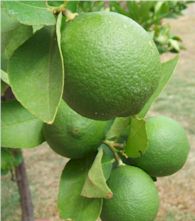
Lime Slices |

Lime Tree |

Whole Lime |
Though not a native of Great Britain, yet, because of its common growth in our roadways and along the front of terraced houses, and in suburban avenues, the Lime Tree has become almost indigenous.
In the old "Herbals" it is called Lyne or Line, Tillet, Till tree, and Tilia, each of these names bearing reference to the bast or inner bark of the tree, which is used in the North for cordage. Others say the name is an alteration of Telia, from telum, a dart, alluding to the use of the wood. Tilia is more probably derived from ptilon, a feather, because of the feathery appearance of the floral leaves.
Shakespeare says:
"Now, tell me thy name, good fellow," said he, "Under the leaves of lyne."
The "n" in later writers has been changed into "m."
Its sweet-smelling and highly fragrant flowers blossom in May, and are much sought after by bees, because abounding with honied nectar. A medicinal tincture (H.) is made from them with spirit of wine; and when given in doses of from five to ten drops with water, three times in the day, it serves to relieve sick bilious giddiness, with depression of spirits, and a tendency to loose bowels, with nervous headache. The sap of the Lime Tree (Tilia Europoea) abounds in mucilage,
from which sugar can be elaborated. A tea made from the blossoms and leaves with boiling water, is admirable for promoting perspiration. It is because of a long established reputation for giving relief in chronic epilepsy or the falling sickness, and of curing epileptiform headaches, whilst proving of indisputable usefulness in allied nervous disorders, that the flowers and leaves of the Lime or Linden Tree occupy a true place among modern medicinal Simples. Gilbert White
made some Lime-blossom tea, and pronounced it a very soft, well-flavored, pleasant saccharine julep, much resembling the juice of liquorices. This tea has been found efficacious for quieting hard coughs and for relieving hoarseness.
The flowers easily ferment, and being so fragrant may be used for making wine: likewise a fine flavored brandy has been distilled from them. The fruit contains an oily substance, and has been proposed, when roasted, as a domestic substitute for chocolate. The sap may be procured by making incisions in the trunk, and branches. The flowers are sedative, and anti-spasmodic. Fenelon decorates his enchanted Isle of Calypso with flowering Lime trees. Hoffman says "Tilioe ad mille
usus petendoe".
The inner bark furnishes a soft mucilage, which may be applied externally with healing effect to burns, scalds, and inflammatory swellings. Gerard taught, "that the flowers are commended by divers persons against pain of the head proceeding from a cold cause; against dizziness, apoplexy, and the falling sickness; and not only the flowers, but the distilled water thereof." Hoffman knew a case of chronic epilepsy recovered by a use of the flowers in infusion drunk as tea. Such,
indeed, was the former exalted anti-epileptic reputation of the Lime Tree, that epileptic persons sitting under its shade were reported to be cured.
A famous "Lind" or Lime Tree, which grew in his ancestral place, gave to the celebrated Linnaeus his significant name. The well-known street, unter den L?en in Berlin, is a favorite resort, because of its pleasant, balmy shade; and when Heine lay beneath the Lindens, he "thought his own sweet nothing-at-all thoughts." The wood of the Lime Tree is preferred before every other wood fur masterly carving. Grinling Gibbons executed his best and most noted work in this
material; and the finely-cut details still remain sharp, delicate, and beautiful.
Chemically, the Linden flowers contain a particular light, fragrant, volatile oil, which is soluble in alcohol. They are used in warm baths with much success to allay nervous irritability; or a strong infusion of them is administered by enema for the same purpose.
Herb Simples
The Primitive Simplers presented here show the way of life in other generations, it is not suggested or recommended trying them yourself. |
|
Garden
Herbs
Home
History of Herbs
Herb Gardening
Herbs for Beginners
Drying & Preserving Herbs
Indoor Herb Gardening
Herb Garden
Hints & Tips
Herbal
Cooking
Herb Chart
Using Herbs
Culinary Herbs
Herb
Oil and Vinegar
Herb Teas
Herb Candy
Herb Jelly
Herb Simples
Preface
Introduction
Alphabetical Listing

Trade
Recipes Online
Share your Recipes with others!!
|




